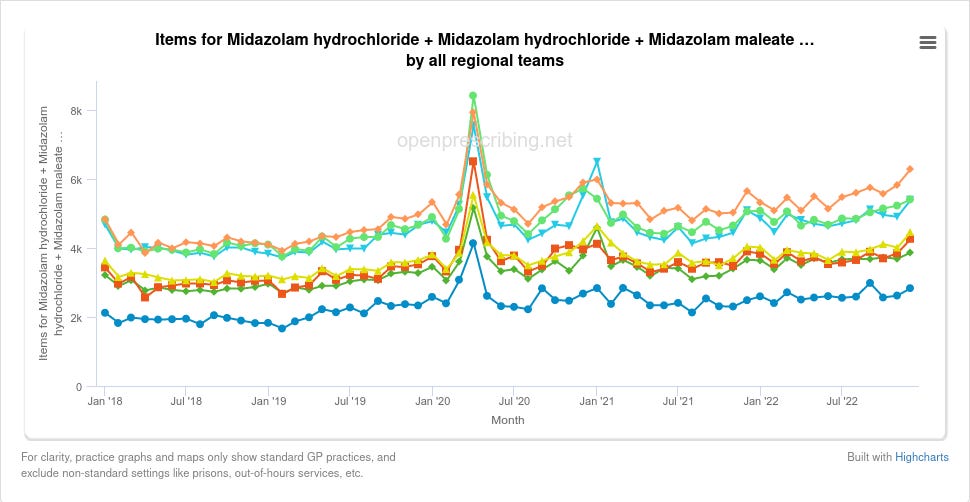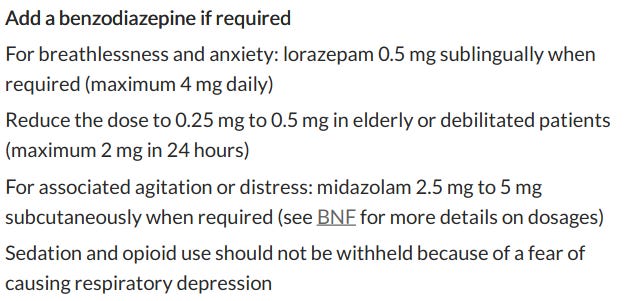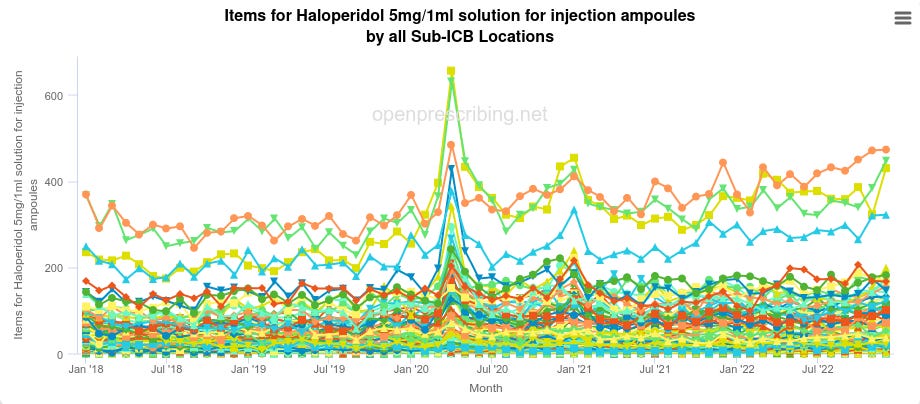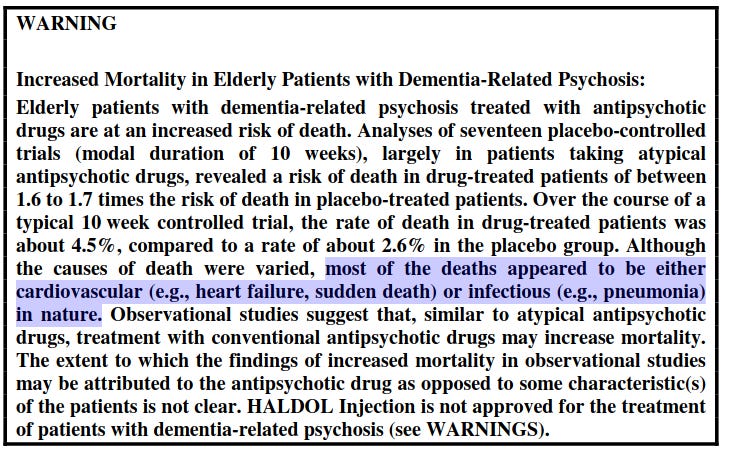Professor Patrick Pullicino; so I have to ask, with diamorphine, propofol, Lorazepam, Fentanyl etc., why the fcuk did we do this to our precious elderly? When 95 times of 100 they were false-positive‘ for COVID as part of the PCR-created fake pandemic?

DR. PAUL ALEXANDER 24.01.2024
IMO, hospitals, nursing homes, old-aged home, care homes, long-term facilities etc. used midazolam, these paralytics, to kill people, they knowingly used them as mass murder of our elderly and high-risk vulnerable…the doctors, yes, our medical doctors, the CEOs of hospitals, the government officials at Health Canada, PHAC, CDC, FDA etc., in Canada, US, UK, Australia etc. must be dragged into a court and shackled in trial and made to defend their actions.
https://banned.video/watch?id=5ee13c3cc7a607002f0c8187
https://expose-news.com/2021/07/31/murder-in-the-care-home-pandemic-plan/
Alexander COVID News-Dr. Paul Elias Alexander’s substack is a reader-supported publication. To receive new posts and support my work, consider becoming a free or paid subscriber.Subscribe

‚‘
When talking of a government sponsored mass murder, what do you imagine they would do? How do you imagine it would play out?
Escorting of the elderly one-by-one into some sort of death chamber? Have roving execution vans? Rounding the elderly up into quarantine camps or FEMA camps and delivering a lethal blow?
These are all very over-the-top, overt, obvious things to look for.
What if, surviving members of Nazi Germany’s government, had intended to learn from their mistakes, of what went wrong and their subsequent failures?
Avoiding Resistance
So instead of high key, overt mass murders that are obvious to everyone — invoking a sense of outrage and resistance — they adopted a more low key, subtle approach? How would that look?
Instead of killing the elderly in giant, overt death camps, they quietly came to their care homes and killed them there. Instead of publicly declaring the executions, they smudged and misreported and reclassified the deaths.
Instead of boldly proclaiming the killings, they quietly lied and denied. Instead of using just one approach to kill, they used several, that if the elderly didn’t die by extreme neglect, then they denied supporting family access and killed them by lethal shot.
This is an in-depth dive. What you are about to read will shock you.
Enter Midazolam
Originally highlighted by Jikkyleaks, Midazolam is a benzodiazepine, a class of ‘depressant’ drug. A depressant is a type of chemical that reduces or impedes a certain activity or activities within the body.
Midazolam, like many other benzodiazepines, is a CNS depressant. CNS stands for ‘Central Nervous System’, and the central nervous system regulates things like movement, breathing, heart beat and more. If it involves a muscle, chances are it involves the central nervous system.
In April 2020, Midazolam prescriptions skyrocketed.

The prescriptions were for Midazolam Hydrochloride, and Midazolam Maleate:

Midazolam Hydrochloride (AKA Midazolam HCL) is the injectable form:

Midazolam Maleate is the oral form:

The majority of the prescriptions were for the injectable form (~97%):

It is unlikely these drugs were taken willingly or with consent given the oral form exists and was not used so extensively.
The Use Of Midazolam
On 3rd April 2020 — NICE (National Institute for Health and Care Excellence) issued guidance NG163 (NG — NICE Guidance) — which recommended the use of benzodiazepines, including Midazolam, for mere “agitation or distress”:

Lorazepam is mentioned, but unlike Midazolam, we don’t see the giant spike in April 2020 for Lorazepam.

This is likely due to the fact “Midazolam has a faster onset and shorter duration of action than other benzodiazepines such as diazepam and lorazepam lending itself to greater flexibility in dosing than other benzodiazepines”.
The NICE guidance tells administrators of the Midazolam shots to ignore any concerns they might have about causing suffocation (“respiratory depression”; where the patient is unable to breathe due to finding it harder and harder to move their lungs using their diaphram):
Sedation and opioid use should not be withheld because of a fear of causing respiratory depression
Yet within NG163 it contradicts this advice underneath and says benzodiazepines do not have a marketing authorisation “for this indication or route of administration”:

That is to say, what they’re doing is illegal and medically unsound, and NICE know it.
In a two-faced move, a month prior, NICE issued contradictory guidance in a failed attempt to exonerate themselves from the planned mass murder campaign:
Healthcare professionals are advised to only co-prescribe if there is no alternative and, if necessary, the lowest possible doses should be given for the shortest duration.
Does this chart look like they were given the ‘lowest possible doses’ for ‘the shortest duration’?

The UK government also contradicted NICE’s advice:
benzodiazepines (and benzodiazepine-like drugs) and opioid medicines (opioids) can both cause respiratory depression; when used together, additive effects on the central nervous system increase the risks of sedation, respiratory depression, coma, and death
Additive means ‘stacks up’, so the combination of both benzodiazepine-like drugs and opioids has a stacking effect on impeding the ability for the elderly to breathe. Even if, incomprehensibly, you believe this was to “treat” SARS-CoV-2, if SARS-CoV-2 is a respiratory virus, impeding their ability to breathe essentially amounts to assisting their deaths.
End Of Life
Midazolam is used in so-called ‘End of Life care’(also known as ‘Palliative care’), which is double-speak terms for administering drugs that ‘help’ patients they think are dying to pass on faster, often painted as ‘easing their passage’, when instead it makes things like breathing more difficult.
Midazolam literally causes patients to fall asleep, as one study notes using it as an ‘antipsychotic’over Haloperidol:
Evidence for the superiority of midazolam over haloperidol for managing motor agitation is encouraging, but it is overly sedating and the majority of patients treated with midazolam fell asleep after intramuscular administration (Mendoza 1987).
Interestingly, as highlighted by Dr John Campbell, injectable Haloperidol — the aforementioned antipsychotic drug — had prescriptions that spiked during April 2020:

Haloperidol has been shown to cause increases in mortality in the elderly, where:
[…] most of the deaths appeared to be either cardiovascular (e.g., heart failure, sudden death) or infectious (e.g., pneumonia) in nature. […]

If that sounds vaguely familiar, it ought. Pneumonia is a generalised term for inflammation of the lungs. The same symptomology as COVID-19.
How convenient — administer a drug that causes the same symptomology as COVID-19, then administer another drug to “treat” it resulting in deaths.
Also highlighted by Dr John Campbell was Levomepromazine (AKA Nozinan, Levoprome, Detenler, Hirnamin, Levotomin and Neurocil), is a phenothiazine neuroleptic drug, another antipsychotic drug, also used in ‘palliative care’.
Prescriptions for injectable Levomepromazine also spiked in April 2020:

Levomepromazine is used by NICE as a sedative.

You can see all the drugs prescriptions spiking together in April 2020:

It is unclear how causing someone to fall asleep with Midazolam, sedating them with Levomepromazine, giving them pneumonia and heart issues with Haloperidol, would aid in their breathing clearance or recovery, especially if NICE guidance recommends continual dosage.
Midazolam works so well at depressing the Central Nervous System that in 2009 the New South Wales (NSW) Ministry of Health recommended it for use in epilepsy to stop convulsions in children. The study goes on to note that: “Repeat doses may be effective but increase the risk of complications”.
Notice that the drugs are essentially used to control people with neurological (mental) disorders and spasms. Not breathing disorders.
Harmful Drugs
That is to say, these drugs are not beneficial drugs that bring treatment to a respiratory disease, nor do they aid with breathing, nor do they offer viral clearance, nor secondary bacterial clearance, nor do they supply nutrients, nor oxygen, nor are they intended to help a patient to recover. They either sedate or kill.
At the time of the previously published Cochrane review, there was no evidence for a beneficial effect of benzodiazepines for the relief of breathlessness in people with advanced cancer and chronic obstructive pulmonary disease (COPD).
“Benzodiazepine poisoning in elderly”:
Elderly may be at greater risk compared with younger individuals due to impaired metabolism and increased sensitivity to benzodiazepines.
Massive benzodiazepines overdose in elderly may be associated with a significant morbidity, including deep coma with aspiration pneumonia, respiratory failure, and even death.
They are designed to sedate a patient, reduce movement to such a degree they can halt epileptic seizures in their tracks, and when it comes to breathing, greatly impede survival chances when paired with opioids — by the UK government’s own admittance.
[…] increase the risks of sedation, respiratory depression, coma, and death
Elderly Deaths Reclassified; Spike Three-Fold April 2020
Naturally, all these Midazolam overdose deaths have to go somewhere, right?
Well, they weren’t classified as what they are — overdose deaths:
- 2019: “4,393 deaths related to drug poisoning were registered in 2019 in England and Wales”
- 2020: “4,561 deaths related to drug poisoning were registered in England and Wales”
- 2021: “4,859 deaths related to drug poisoning were registered in 2021 in England and Wales”
As you can see, barely the slighest increase in deaths. So, where were the majority of deaths from April hidden?
They were reclassified as dementia deaths. A neurological (mental) disorder that retroactively “justifies” the use of an antipsychotic drug. This isn’t mere speculation either, there’s a peer-reviewed paper stating as much:

Read that again:
[…] 17 316 patients died in England in April, 2020, with “dementia and Alzheimer’s disease” recorded on their death certificate. This number of deaths was nearly three times more than expected […]
Over 17 thousand elderly patients died in April 2020; the same month NICE published guidance to use Midazolam regardless of the consequences; the same month Midazolam injectables shot up, the same month 17,316 patients died, three times greater than normal, supposedly from a mental disorder (that mysteriously just cropped up during the peak start of a pandemic)…
…The same month antipsychotic prescriptions shot up:
[…] the overall number of registered patients meant that the proportion of patients who have been prescribed antipsychotics substantially increased […]
Rates in March, April, and May, 2020, were substantially higher than in the same months in 2018 (increased by 4·40%, 6·95%, and 5·22%, respectively) and 2019 (increased by 4·28%, 7·34%, and 4·87%, respectively).
…The same month they were “overrepresented” in the additional deaths
People with late-stage dementia and those within care facilities, who would be the group most likely to be prescribed antipsychotics, were over-represented among the additional deaths in April, 2020
…The same month no justification could be found for the increased prescriptions:
The register does not record specific indications for antipsychotic prescribing, and it is possible that some of the increase related to delirium management or palliative care, although most of the increase was probably in response to worsened agitation and psychosis secondary to COVID-19 restrictions
…where the paper tries to blame “worsened agitation” or “psychosis secondary” caused by lockdown for the sudden jump in mass injections of ‘antipsychotics’.
Whistleblowers Reported Misuse
Back in July 2020, The Daily Mail ran a story asking the question “did care homes use powerful sedatives to speed Covid deaths?”:

The Daily Mail claimed whistleblowers “witnessed misuse of sedatives, with staff told to give them to dementia patients”. The justification? To stop them ‘wandering corridors’. But no mass murder campaign could be based on such a trite reasoning.
The article quotes a number of experts who concur it was nothing but a death machine:
Retired neurologist Professor Patrick Pullicino, who was instrumental in raising concerns a decade ago that the Liverpool Care Pathway was bringing forward patients’ deaths, believes the jump indicated something similar had happened. He said: ‘Midazolam depresses respiration and it hastens death. It changes end-of-life care into euthanasia.’
Professor Patrick Pullicino goes on to observe that:
[…] an official flow-chart intended to help health workers decide if people sick with Covid-19 were suitable for intensive care wrongly consigned those deemed too frail to end-of-life care.
[…] to me this flow-chart encouraged use of end-of-life sedation with midazolam – effectively resulting in euthanasia pathways.
Eileen Chubb expressed that care home workers were under the definite impression not to save elderly lives by sending them to hospital, invoking the neglect portion of the mass murder campaign:
Eileen Chubb, of the charity Compassion in Care, said a number of care-home workers had told her sedatives were used too freely during the pandemic, adding that some staff were under the ‘definite impression’ that very sick care-home residents should not be sent to hospital.
https://www.jhunewsletter.com/article/2020/11/a-closer-look-at-u-s-deaths-due-to-covid-19
Covid-19: Remdesivir has little or no impact on survival, WHO trial shows. https://www.bmj.com/content/371/bmj.m4057
Hinterlasse einen Kommentar